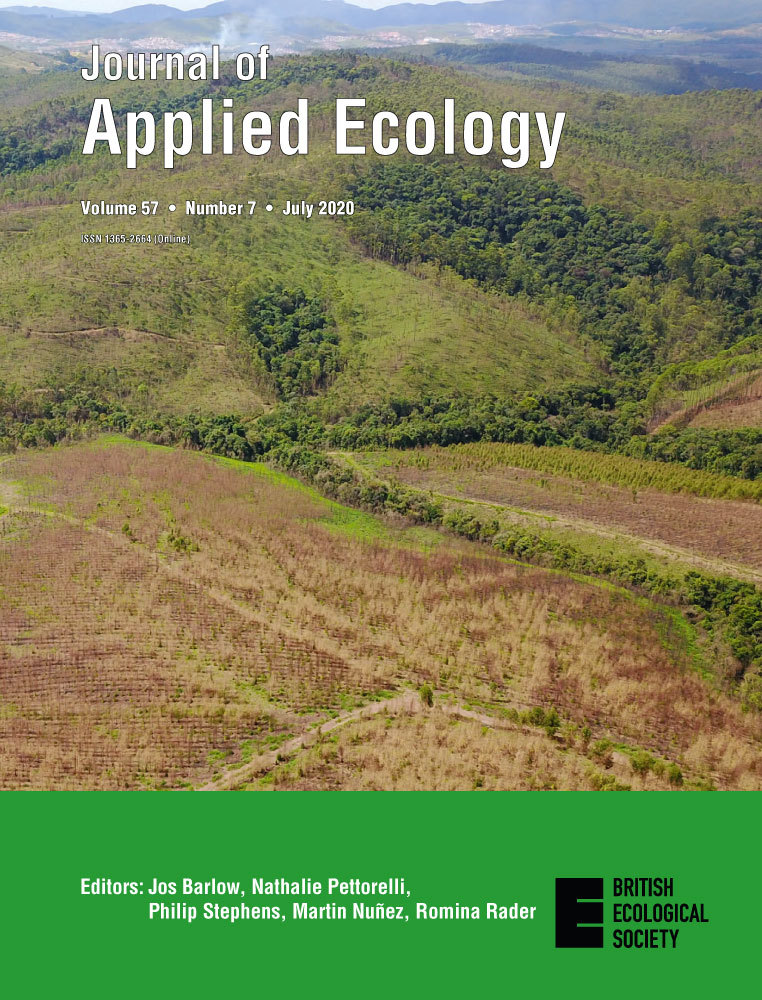View Item
- xmlui.general.dspace_homeCentros e Institutos de InvestigaciónCIRN. Centro de Investigaciones de Recursos NaturalesInstituto de Recursos BiológicosArtículos científicosxmlui.ArtifactBrowser.ItemViewer.trail
- DSpace Home
- Centros e Institutos de Investigación
- CIRN. Centro de Investigaciones de Recursos Naturales
- Instituto de Recursos Biológicos
- Artículos científicos
- View Item
Trade‐offs between biodiversity and agriculture are moving targets in dynamic landscapes
Abstract
Understanding how biodiversity responds to intensifying agriculture is critical to mitigating the trade‐offs between them. These trade‐offs are particularly strong in tropical and subtropical deforestation frontiers, yet it remains unclear how changing landscape context in such frontiers alters agriculture–biodiversity trade–offs. We focus on the Argentinean Chaco, a global deforestation hotspot, to explore how landscape context shapes trade‐off curves
[ver mas...]
Understanding how biodiversity responds to intensifying agriculture is critical to mitigating the trade‐offs between them. These trade‐offs are particularly strong in tropical and subtropical deforestation frontiers, yet it remains unclear how changing landscape context in such frontiers alters agriculture–biodiversity trade–offs. We focus on the Argentinean Chaco, a global deforestation hotspot, to explore how landscape context shapes trade‐off curves between agricultural intensity and avian biodiversity. We use a space‐for‐time approach and integrate a large field dataset of bird communities (197 species, 234 survey plots), three agricultural intensity metrics (meat yield, energy yield and profit) and a range of environmental covariates in a hierarchical Bayesian occupancy framework. Woodland extent in the landscape consistently determines how individual bird species, and the bird community as a whole, respond to agricultural intensity. Many species switch in their fundamental response, from decreasing occupancy with increased agricultural intensity when woodland extent in the landscape is low (loser species), to increasing occupancy with increased agricultural intensity when woodland extent is high (winner species). This suggests that landscape context strongly mediates who wins and loses along agricultural intensity gradients. Likewise, where landscapes change, such as in deforestation frontiers, the very nature of the agriculture–biodiversity trade–offs can change as landscapes transformation progresses.
Synthesis and applications . Schemes to mitigate agriculture–biodiversity trade–offs, such as land sparing or sharing, must consider landscape context. Strategies that are identified based on a snapshot of data risk failure in dynamic landscapes, particularly where agricultural expansion continues to reduce natural habitats. Rather than a single, fixed strategy, adaptive management of agriculture–biodiversity trade–offs is needed in such situations. Here we provide a toolset for considering changing landscape contexts when exploring such trade‐offs. This can help to better align agriculture and biodiversity in tropical and subtropical deforestation frontiers.
[Cerrar]

Author
Macchi, Leandro;
Decarre, Julieta;
Goijman, Andrea Paula;
Mastrangelo, Matías Enrique;
Blendinger, Pedro Gerardo;
Gavier Pizarro, Gregorio Ignacio;
Murray, Francisco;
Piquer‐Rodriguez, María;
Semper-Pascal, Asunción;
Kuemmerle, Tobias;
Fuente
Journal of Applied Ecology (First published: 21 July 2020)
Date
2020-07
Editorial
Wiley
ISSN
0021-8901
1365-2664
1365-2664
Documentos Relacionados
Formato
pdf
Tipo de documento
artículo
Proyectos
(ver más)
INTA/PNNAT/1128053/AR./Evaluación y manejo de la biodiversidad y sus servicios ecosistémicos de interés para la producción agropecuaria.
INTA/PNNAT/1128052/AR./Desarrollo de herramientas y validación de metodologías para el estudio, gestión y manejo de los sistemas productivos, contribuyendo a su resiliencia socio agroambiental.
Palabras Claves
Derechos de acceso
Abierto
 Excepto donde se diga explicitamente, este item se publica bajo la siguiente descripción: Creative Commons Attribution-NonCommercial-ShareAlike 2.5 Unported (CC BY-NC-SA 2.5)
Excepto donde se diga explicitamente, este item se publica bajo la siguiente descripción: Creative Commons Attribution-NonCommercial-ShareAlike 2.5 Unported (CC BY-NC-SA 2.5)


